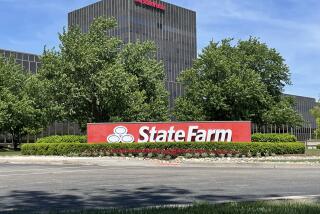Auto Insurance Crisis Possible, Regulator Says
- Share via
BOSTON — A new insurance crisis, generated by rising automobile insurance rates, may be brewing, the president of the National Assn. of Insurance Commissioners warned Monday.
But if insurers allow an auto insurance crisis to materialize, similar to the current shortage in commercial and municipal liability coverage, they themselves will prove to be the ultimate victims, predicted Josephine Driscoll, NAIC president and Oregon’s insurance commissioner.
A year ago, speaking to members of the same organization, the chairman of Lloyd’s of London said the industry had “shot itself in the foot” with rampant rate slashing in order to gain premium dollars to invest at the high interest rates that prevailed several years ago. The cut-rate pricing helped generate huge claims losses that income--with interest rates falling--could not cover, prompting many insurers to pull out of certain high-risk areas and to raise rates sharply in others.
On Monday, Driscoll told the state regulators and insurance representatives here for a weeklong meeting: “I am sorry to say it appears the industry is taking aim at the other foot.”
Could Trigger Public Backlash
Should companies now refuse to write automobile or homeowners insurance, or sharply raise those rates, she said, it could trigger a public backlash that could bring federal regulation of an industry traditionally watched over, with varying degrees of effectiveness, by the 50 states.
Later, Driscoll said in an interview that she based her remarks on a rising tide of consumer complaints in her state regarding cancellation of auto insurance, changes in underwriting practices damaging to consumers and increasingly frequent rate increases--in some cases monthly.
At least three companies have temporarily stopped writing new auto insurance policies in Oregon, she said, adding: “Ordinarily, if something like this starts in our state, it also starts in other states as well.”
However, Frank Nutter, president of the Alliance of American Insurers, a trade group of property and casualty insurance companies, disputed Driscoll’s contention that a new insurance “crisis” is on the way.
“Crisis is an overstatement,” he said in an interview.
Rates for both auto and homeowners insurance have been increasing, he said, but far more modestly than for commercial liability insurance. For one thing, he said, writers of auto and homeowners insurance never engaged in the predatory pricing that took place in the commercial liability field, so their premiums have kept pace better with rising costs. On the other hand, Nutter said, big jury awards for non-economic damages have affected personal lines of insurance to a degree.
Auto insurance rates will likely increase by less than 10% this year, he said. This would represent a substantial enough increase, given the present low rate of inflation, he acknowledged, but would be modest compared to the doubling and tripling of certain commercial and municipal liability rates. “There is no evidence whatsoever of non-availability” of auto insurance, he added.
Nutter hailed last week’s passage of Proposition 51 in California as “very positive” in indicating the public’s awareness that there are problems within the civil justice system that have generated huge jury awards for virtually unmeasurable pain and suffering.
Passage of the initiative--which limits awards for pain and suffering to a defendant’s share of responsibility for an accident--by nearly a two-thirds majority shows that consumers now view themselves as “victims more of the legal system than of products and services,” Nutter said. On the other hand, he said, enactment last Friday by the Florida Legislature of a law ordering a one-time 40% cut in insurance rates effective Oct. 1 will prove to be “counterproductive.”
Bill Gunter, Florida’s insurance commissioner, pointed out, however, that the 40% slash in rates will actually result in only a 10% cut because it will only apply to premiums in the final quarter of this year. On the other hand, he said, the law also requires insurers to submit new 1987 rate proposals to his office for review--and this is a regulatory departure for the state.
Florida, like California, has been an “open rating” state, in which insurers are free to charge what they wish on the theory that competition will keep rates reasonable. From now on, insurers will have to justify any increases in their rates above what they were on Jan. 1, 1984.






